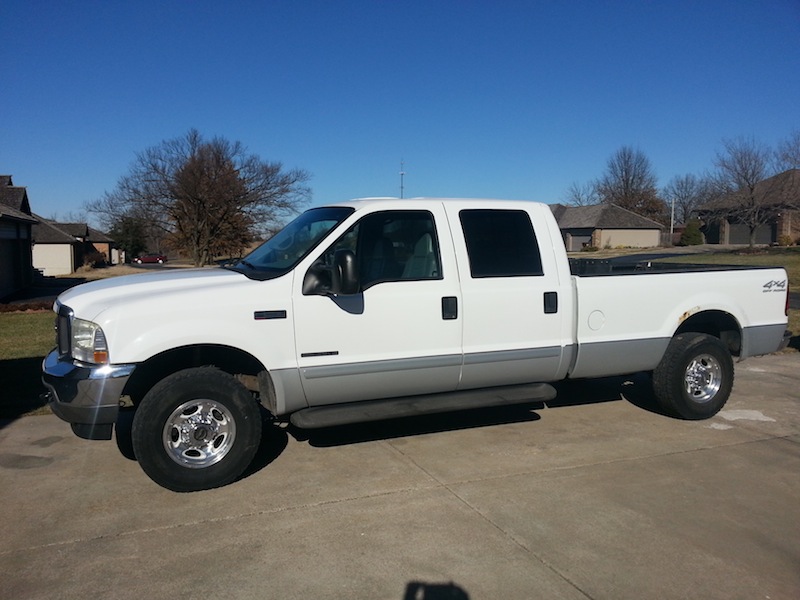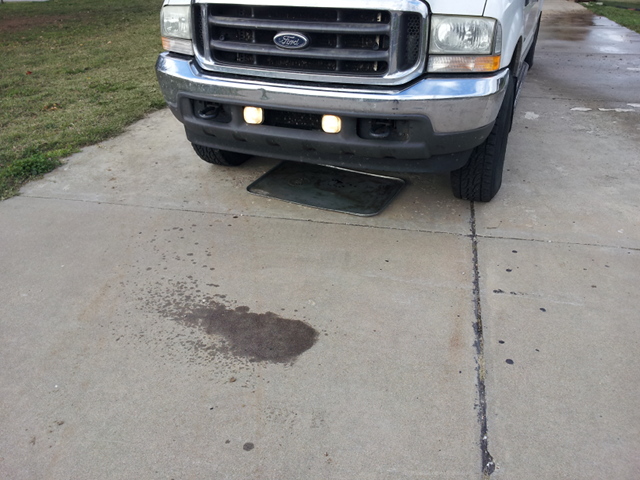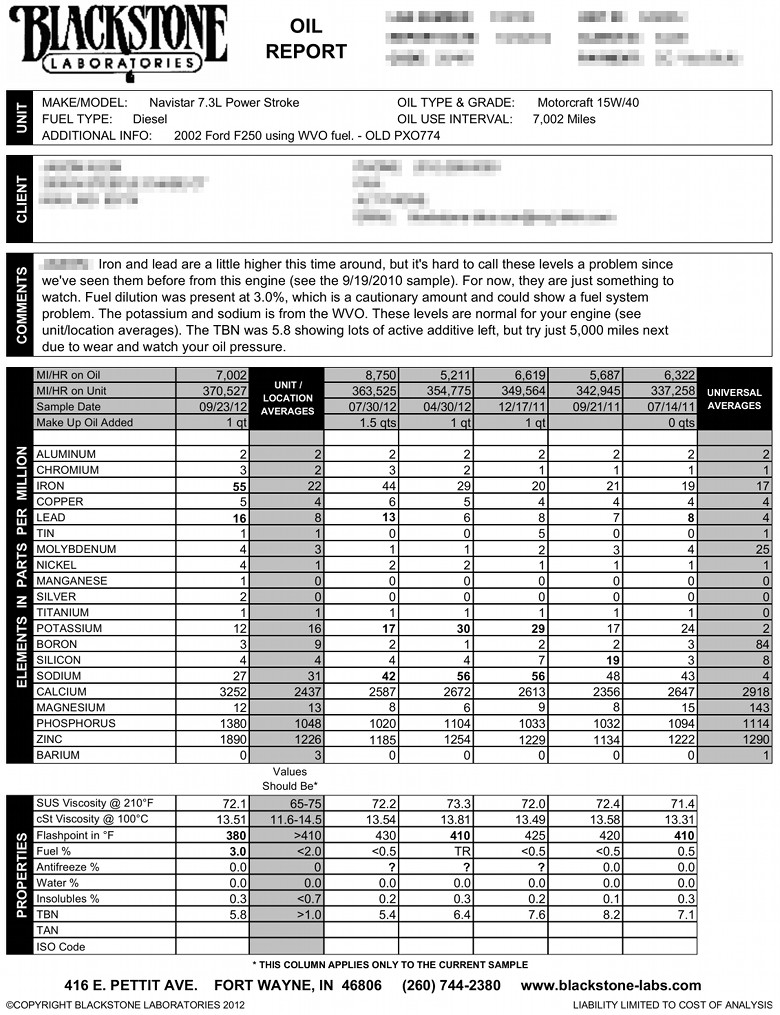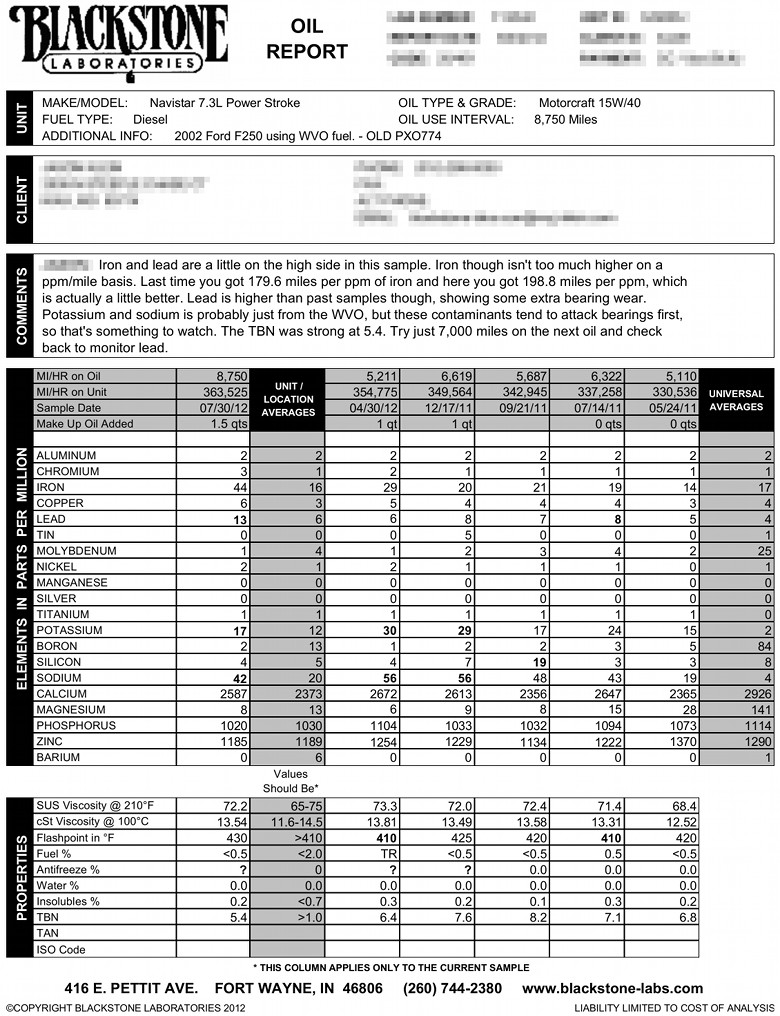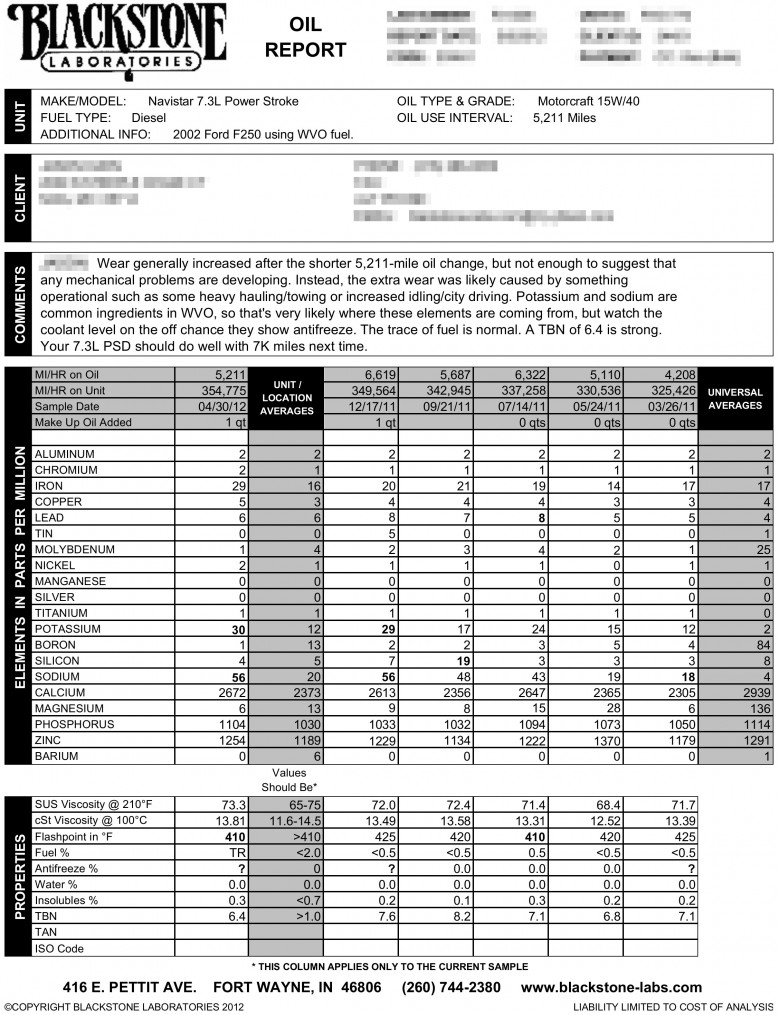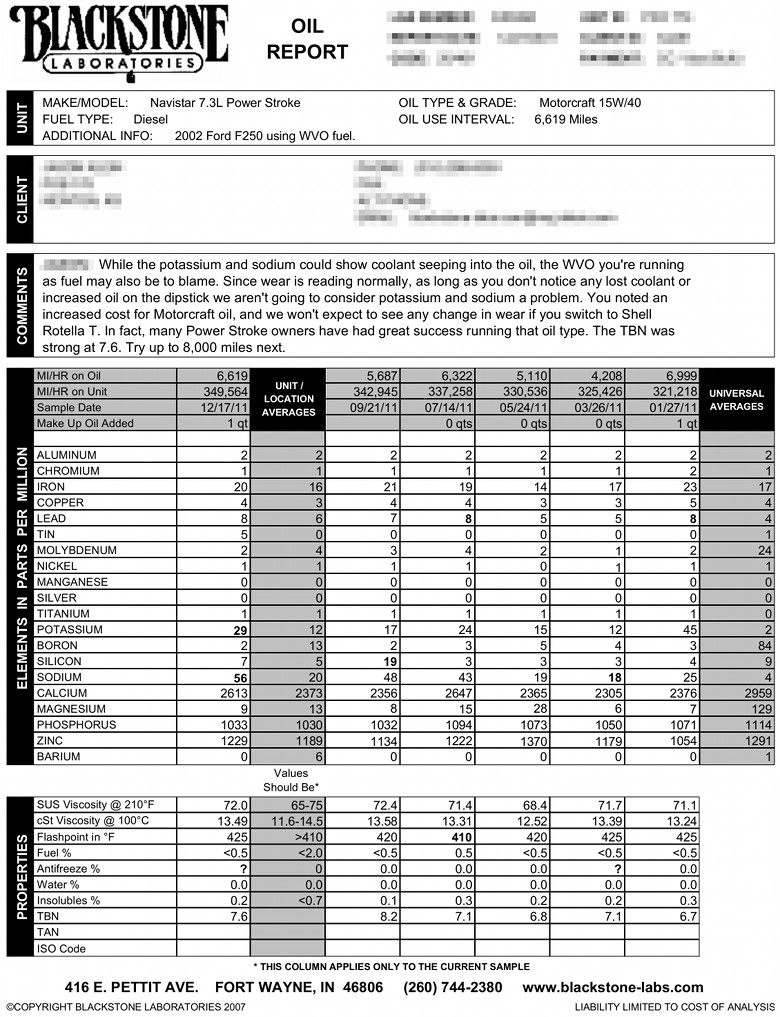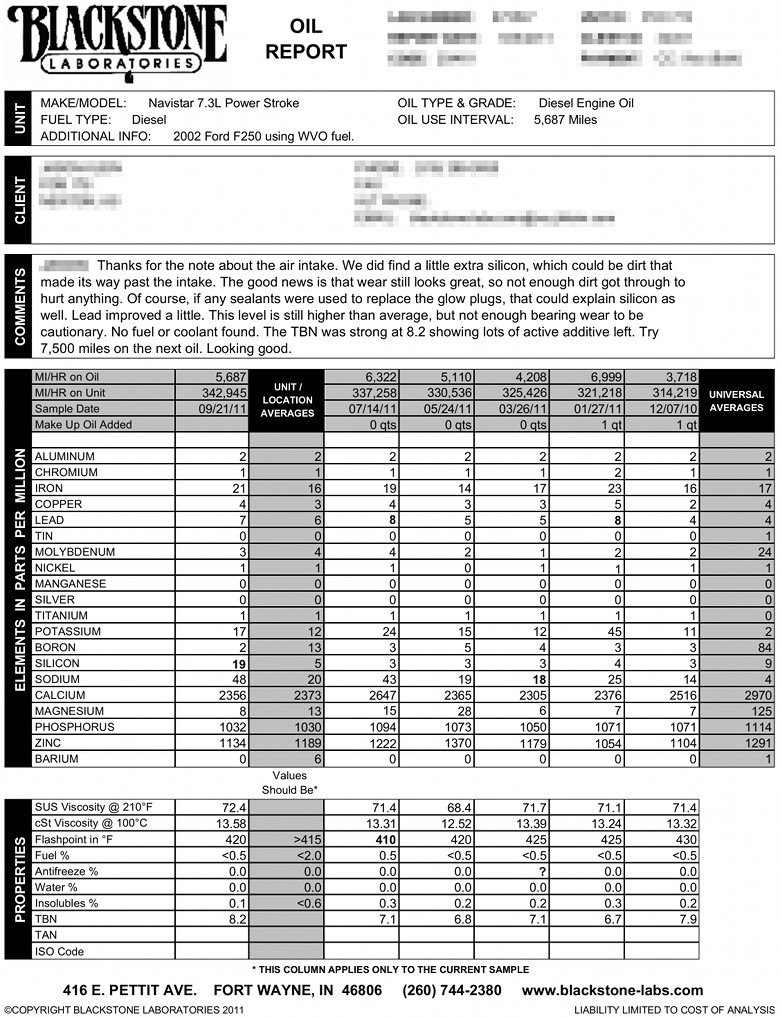Just a note to let everyone know that all is well and that my WVO-powered F-250 is closing in on 370k. Not much worth writing about. Here’s a summary of happenings…
I continue to send oil samples to Blackstone Labs at every 5k oil change interval and continue to see favorable results. Still using MC 15w40 oil ($17.50/5 qt) and MC FL-1995 oil filters ($9.95/ea). These two items are just about the ONLY reason I go to Walmart. When I first started doing the oil changes in ’09, cost was $10.50/5qt and $9.95/filter.
New brake pads all around and new rear calipers at 329k in 05/2011. Went with Wagner ThermoQuiet pads (Amazon.com – EX756 @ 39.63, EX757 @ 39.17) and rear brake calipers from the local parts store. I wasn’t planning to replace the calipers, but one failed a few days before I was planning to install the rear brake pads.
Replaced my glow plugs with ease around 338k in 08/2011, which completely resolved my sluggish startup issues on cold days last winter. I had already replaced my glow plug relay (MC F81Z-12B533-AC, International 1831646C1 @ $40-50) only to learn that was not the problem. Total cost was $315.00 for 8 glow plugs (MC ZD11 F4TZ-12A342-BA @ 9.38), 2 valve cover wiring harnesses (MC F81Z-9D930-AB, International 1830844C93 @ 50.99), and 2 valve cover gaskets (MC F81Z-6584-AA, International 1826703C1 @ 69.49). Purchased from Sean at Geiser Ford (309-923-2141). They often sell on eBay and are much more reasonable than our local dealerships on certain items. Call them for a quote! Very nice to have working glow plugs on those mornings when you forgot to purge WVO.
Batteries didn’t seem to be holding a charge very well. Truck almost did not start after a longer session of pumping WVO with my 12V pump. Interstate tested the MTP-65 batteries and confirmed at least one was defective. They replaced both free of charge at 346k in 10/2011. Batteries were originally purchased at 279k in 10/2009. I would have expected the batteries to cause problems right away or last much longer, but I suspect the 12V heaters on my Racor filters or the 12V pump I use could have caused issues? Regardless, couldn’t have been more pleased with Interstate batteries especially after the unexpected free replacements!
I noticed that my coolant reservoir had become very brittle and had a hairline crack on the top, so I replaced the reservoir around 350k. I don’t think the issue was related to the ELC as much as age. I switched to red ELC (FELCC7997G @ 19.55/gal, local International dealer) coolant around 293k in 05/2010. I mixed this concentrated ELC with distilled water after flushing and flushing all of the green out of my system. Flushing was a PITA, but there are helpful guides online. I basically drained the green, topped off with tap water, ran engine. Repeated until there was only a hint of brown (rust, not green coolant?). Drained one more time, topped of with distilled, ran engine. Drained one last time, and filled with about 55/45 or 60/40 coolant/water mix to account for the remaining water in the cooling system. Should have ended up with close to a 50/50 mix. The coolant claims zero maintenance for 600k (no flushing or SCA additives) and is supposed to be compatible with nearly all 99-03 7.3L PSD engines. The ELC still looks great at about 75k, so I don’t think I am experiencing any WVO contamination issues either. I was initially hesitant to convert at a cost of about $20-25/gallon, but have no regrets. Might even splurge and drain/fill with new ELC after 200k just to be safe.
Changed my transmission fluid and transmission filter (screen in pan) at 354k in 04/2012. Fluid looked great and very small amount of debris on magnet. Probably could have run the fluid longer, but glad to think that my transmission is doing well. Purchasing Valvoline ATF DexIII/Mercon by the case (12 quart) for $46.27+TAX from a local Valvoline wholesaler. Purchasing Motorcraft FT114 Automatic Transmission Filter 7R100 from Geiser Ford (via eBay) for $22.99 each. I believe I am still using the original transmission which hasn’t needed anything except regular service since I purchased the truck at 250k.
Completely cleaned out my Racor-1000 filters and installed the rebuild kits at 354k in 04/2012. I really only needed the check-valve kits (Racor RK11028B Check Ball Kit @ 15.50), but it seemed sensible to replace all of the seals for an extra few dollars (Racor RK11-1404 Seal Kit @ 27.50, allpointsmarineco.com). If I had to do it again, I would just purchase the check-valve rebuild kits. The other seals and gaskets seemed to be in good shape after 100-120k of service. Each Racor filter includes replacement seals for the lid and the larger of these seals seems to be identical to the other main seal in the filter. I had been aware for quite a while that my check-valves were failing. One time, this left me stranded because I replaced the filter elements but forgot to top off the filter bowls with fuel. Since the check-valves were failing, the canisters would completely drain if you left the lid open too long. The check-valve ball was perfectly fine, but the check-valve gasket was very brittle and cracked in both filters. If someone could sell the check-valve gasket by itself for a few dollars, they would make a fortune. Ridiculous paying $15 for the ball and seal/gasket when you only need the seal/gasket.
After recommendations from several friends, I switched to TreadWright tires. I went with an aggressive read last fall (4x 265/75R16 GUARD DOG M/T (E) @ $111 ea). Found a great deal on a second set of original 99-03 F-250 wheels on CraigsList, so I purchased another set of TreadWright tires with highway tread and switched to them this spring (4x 265/75R16 SENTINEL A/T (E) @ $108 ea). Will keep the more aggressive tires for the winters. Both sets are wearing very well, but I am rotating them about every 5k to be safe. Other than an issue with the first set being balanced incorrectly (easily corrected), I am very impressed.
My sources for WVO are changing, possibly for the better though my cost has increased from $0/gal to $1.50/gal. I’ve recouped my initial costs enough times that I’m willing to spend some money on fuel if it simplifies my operation. Now picking up oil in pre-filtered 35LB (4.5gal) containers (20-60 at a time) instead of 55gal drums, storing in my garage, and dumping the very clean oil directly into the truck. Much easier than all of the pumping and settling I was doing, but only because I am using a small 12V pump and only moving 55gal at a time. I can dump 12 of these small containers into my truck faster than I could pump 55gal and I don’t have to worry about settling at all at the moment.
